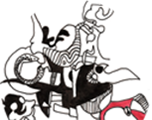Source of the material
The ideas and sources for my drawings come from a variety of places. In the late 1990s I started to copy (either with tracing paper or freehand) images of space, toys, Japanese folk tales, and pop culture into notebooks. I was also collecting quotes from books in these notebooks as well. It was my hoarding, but it didn't take up too much space. I am posting some of these pages on this site under the sketchbook section.
By the turn of the century I was doing large tracings on rolls of tracing paper. Do you know the movie Slaves of New York? In one scene the artist Stash is using a polaroid to photograph images from a Popeye cartoon that he will eventually use in his paintings. I always wanted to do something like that.
Instead of a polaroid I used tracing paper, which I would tape to the tv screen and trace what I could see in colored pencils. In some cases I used VHS tapes and paused them, later I would do the same with DVDs (much better picture when paused). I would also use live tv to do really quick sketches.
I was also using the tracing paper to copy more detailed images from books. These have become source material for my later drawings (and drawings to come). I started to copy mechanical diagrams, ornamental patterns, space and robot toys, architectural plans, etc. I have these fragile scrolls all together next to the sketchbooks.
Sewn pieces
At one point I had a lot of scraps of paper (too many samples from printing classes). Some of those went into making ATCs (see below), I used the rest to experiment on how ink, wax, colored pencils, and different mediums interact. Once I was finished, I chose the best and stitched them together into bigger pieces. This would lead to a giant sewn piece I exhibited in Windows Arts Malden.
The Growth Series
While working on the growth series on vinyl, I would also do some sketching on vellum paper to work out patterns, play with ideas and let the growths go wild to see what would happen. I wanted to use vellum not only for the translucent feeling, but also for the way ink sits on the paper rather than sinks.
Artist Trading Cards
In the early 2000s I was an active part of an online artist community and constantly participating in artist trading card (ATC) swaps. The idea of using a small surface to create something that would then be traded felt very liberating. I must have created hundreds of cards for trades. Most are now out among the community. I was able to take photos of some of those cards, which I've added to this page.

